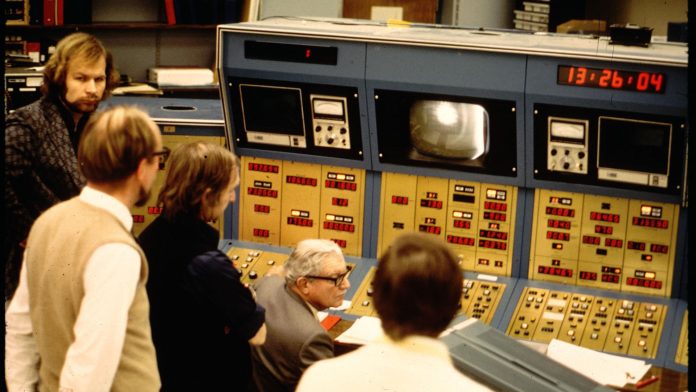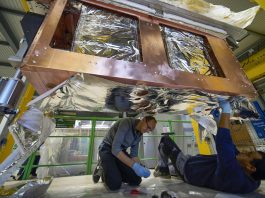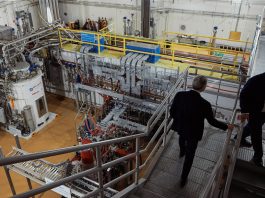TRIUMF reflects on five decades of discovery since the world’s largest cyclotron was activated at the centre.
This year, Canada’s particle accelerator centre, TRIUMF, is celebrating an anniversary like no other: 50 years since the first beam from the laboratory’s 520 MeV cyclotron.
In 2024, the laboratory’s community will look back to the momentous afternoon of 15 December 1974, when a small team of physicists, engineers, and critical support staff activated the world’s-largest cyclotron, a type of particle accelerator, and coaxed forth Canada’s first high-energy proton beam.
Across the last five decades, TRIUMF’s cyclotron, the beams it produces, and the dedicated community that has stewarded many myriad contributions and successes have made an indelible mark on both the national landscape of Canadian science and the international ecosystem of ‘Big Science’, in which TRIUMF is now a major player.
History in the making
Nestled between forest and sea on a 13-acre campus on the western edge of Vancouver, British Columbia, TRIUMF has remained at the leading edge of world-class research for 50 years, continuously adapting to the needs and new paradigms of subatomic physics.
The laboratory has reinvented itself at several key junctures over its 50-year history, transforming from a ‘TRi-University Meson Facility’ into a leading national and international scientific hub with over 20 member universities from coast to coast.
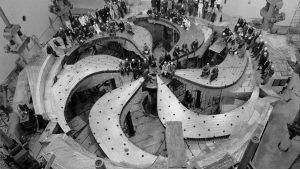
The original 520 MeV cyclotron, which continues to drive a sizable portion of the TRIUMF research programme, is an 18-metre, 4400-tonne, negative-hydrogen-ion accelerator. The laboratory’s community of world-renowned accelerator science experts has implemented a variety of modern controls and upgrades to keep the machine running at maximum capacity and fuelling programmes in particle and nuclear physics, life sciences, materials sciences, and more. TRIUMF’s infrastructure has grown to accommodate these many experimental, user-focused capabilities, and industry collaborations, and the 520 MeV cyclotron has also been joined by a suite of additional accelerators, including compact medical isotope cyclotrons and linear accelerators.
TRIUMF’s inception can be traced back to the early 1960s, driven by a strong desire for collaboration among three Canadian universities and a novel accelerator concept: the world’s largest cyclotron, to be used primarily for experiments in particle physics. In June 1965, a meeting among representatives from the University of British Columbia, the University of Victoria, and Simon Fraser University solidified a proposal for a tri-university meson facility based on an existing, smaller, cyclotron design. Within three years, the group had secured C$19m in federal funding, and construction began in 1968.
The construction of the cyclotron involved a highly diverse team of contributors, from scientists and engineers to technicians, administrators, students, and others, many of whom were recent graduates or early-career professionals. The organisation combined university faculty directing engineers and consultants responsible for key components of the cyclotron, such as its ion source and vacuum, radiofrequency, and magnet systems.
After overcoming initial challenges, the first beam from the cyclotron was achieved on 15 December 1974, marking the beginning of a comprehensive experimental physics programme that utilised beams of enigmatic subatomic particles: proton, neutron, and muons.
Gary Wait from TRIUMF said: “Every one of the group leaders were in the control room for hours keeping our systems under surveillance as (TRIUMF’s Director Reg Richardson) gradually got the beam circulating to higher and higher energies. He finally got a radiation alarm from the beamline 4 beamspill monitors followed by a signal moments later. The room exploded in cheers. Exciting day!”
TRIUMF’s scientific programme quickly expanded, leveraging the cyclotron’s capabilities to enable exploration in a variety of research areas, including nucleon interactions and materials science. Researchers at the lab used beams of protons from the main cyclotron for research into nucleon–nucleon and nucleus interactions, as well as secondary beams of pions for nuclear-structure studies and muons as probes for studies in materials science. Taken together, the 520 MeV cyclotron enabled a highly unique and comprehensive scope of research into the atomic nucleus, expanding our understanding of the forces that hold the atomic nucleus together and building critical understanding of the properties of matter. By the early 1980s, TRIUMF was operating the world’s largest cyclotron and had established itself as a premier accelerator laboratory.
New and exciting avenues of research also blossomed, including investigations into the feasibility of producing critically needed medical isotopes using the main TRIUMF accelerator. By the 1980s, TRIUMF had established a shared research programme with the UBC Hospital, providing short-lived radioactive isotopes for use in the burgeoning fields of positron emission tomography (PET) and single-photon emission computed tomography (SPECT). The laboratory began to add facilities to support this new area of opportunity, installing additional compact cyclotrons to produce not only the isotopes required for PET/SPECT scans but also novel, experimental isotopes that could serve as important tools for diagnosing and potentially treating disease.
The winds of change
However, new discoveries in subatomic science and a deeper understanding of the Standard Model of Particle Physics began to change the landscape of international physics. Being a relatively nimble lab and accustomed to doing much with little, TRIUMF sought to propose an even larger facility to respond to these winds of change, one that could be added as an expansion to the current site in Vancouver: a massive, unprecedented 30 GeV ‘KAON’ complex to facilitate high-energy physics experiments. The new accelerator facility was envisioned to produce a high volume and variety of particles for use in physics research, including ‘Kaons, Antiprotons, Other hadrons, and Neutrinos’. KAON would not necessarily compete with the high-energy frontier being pursued by colleagues at CERN but could provide an even broader scope of research capability at medium and low energies.
While the KAON proposal generated substantial interest from both the provincial government, local labour organisers, and international ‘Big Science’ collaborators at many of the world’s physics labs, it ultimately did not receive the necessary political support for funding and was deemed unable to move forward.
The unsuccessful bid for the KAON complex prompted TRIUMF to pivot in two key directions: enhancing Canada’s role in international physics collaborations and developing a new focus on rare isotopes.
TRIUMF’s contributions to international collaborations had become increasingly evident during the decade-long KAON design campaign, where the lab developed significant expertise in accelerator design, the production of targets and associated systems, detectors, and more. This positioned TRIUMF as Canada’s gateway to major international physics initiatives, such as CERN’s Large Hadron Collider (LHC) and the ATLAS collaboration, where Canadian researchers today continue to contribute vital components to accelerators, detectors, computing infrastructure and modelling, and more.

Simultaneously, TRIUMF recognised a growing global interest in rare isotopes, which opened new avenues for research in nuclear astrophysics and fundamental nuclear physics. The lab had identified a worldwide shortage of isotope production facilities and understood its potential role in addressing this issue. Starting with the small TISOL (Test facility of Isotope Separation On-Line) infrastructure, which had been successfully installed in 1987, TRIUMF began producing a different kind of beam: rare isotope beams, comprised of exotic, short-lived versions of the stable elements that make up the world around us.
The process to create rare isotope beams is intensive, and requires massively complex, highly tuned, and thoughtfully radiation-shielded accelerator and target infrastructure. TRIUMF had developed much of the requisite expertise across its multi-decade journey and was eager to use its infrastructure and community of world-leading experts to pivot in this new and exciting direction.
The initial ISOL project led to the development of the Isotope Separator and Accelerator (ISAC), which has since become a leading facility for rare-isotope production. ISAC enables TRIUMF to produce isotopes for various research fields, including studies of heavy element formation in the Universe, investigations into the magnetic and conductive properties of materials like superconductors and next-gen batteries, and exploring symmetries and phenomena beyond the Standard Model of particle physics. Spin-polarized beta-emitting isotopes produced at TRIUMF also support materials science investigations, benefiting research into complex quantum materials.
Building on the expertise gained as part of its accelerator research, design, and construction, TRIUMF has continued to expand its capabilities in isotope science by adding new production facilities that will allow for the production of even more rare isotope beams. Foremost is the Advanced Rare Isotope Laboratory (ARIEL) – a multidisciplinary flagship research facility that brings online a superconducting electron linear accelerator and two additional target stations to produce isotopes. With its proton and electron beamlines, ARIEL is set to triple the output of TRIUMF’s rare isotope science programme and explore innovative applications beyond subatomic physics.
TRIUMF’s history is marked not only by a commitment to scientific advancement but also by a drive for innovation. TRIUMF Innovations, the lab’s commercialisation arm, actively translates research into real-world applications, and has a storied history of successful company creation, technology licensing, and other initiatives that drive impact from TRIUMF’s science. The laboratory’s longstanding commercial partnerships to produce medical isotopes (now with partner BWXT Medical) exemplify this effort: together with BWXT Medical, TRIUMF enables the production of nearly two million patient doses of critically needed medical isotopes used in diagnosing cancer and cardiac conditions for patients around the world. The laboratory’s deep breadth of expertise in accelerator science, built over five decades since first beam, remains a cornerstone in these successful partnerships.
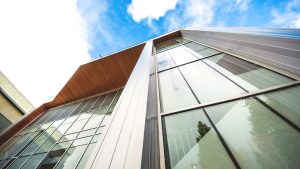
Looking ahead, TRIUMF Innovations will play a key role in advancing the Institute for Advanced Medical Isotopes (IAMI), which brings online an additional compact cyclotron for producing medical isotopes that support new diagnostics and radiotherapies. Additionally, TRIUMF continues to build capacity to produce alpha-emitting therapeutics, scarcely available but crucial isotopes that show tremendous promise for treating advanced cancers. The laboratory’s growing capacity for producing actinium-225 will enable even more clinical trials, accelerating the development of promising new therapies and improving health outcomes for Canadians and people around the world.
Looking ahead to the next 50 years of beam and beyond, TRIUMF will continue to adapt to the needs of society and the physics community by continuing to improve its facilities, expand its world-leading accelerator science community, and tackle new scientific challenges. With a legacy built on exploration and discovery, and a proven track record of success, TRIUMF will continue to drive impact and benefit for all for decades to come.
Please note, this article will also appear in the 20th edition of our quarterly publication.

